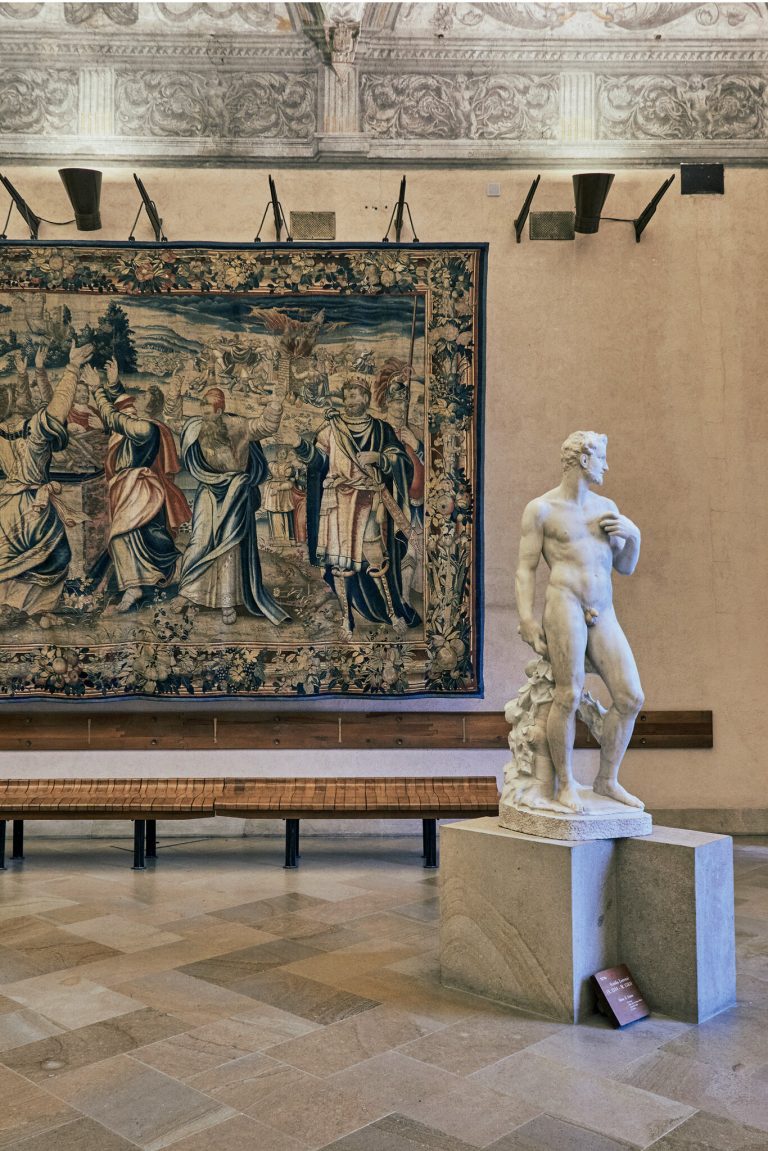Milan is among Italy’s largest and most influential cities: Founded in 590 B.C., it eventually became the capital of the Lombardy region. Yet for centuries, it was somewhat overlooked as a cultural hub; while Rome, Florence and Venice were widely viewed as Italy’s seats of intellectual and artistic production, Milan was seen mainly as a gray, unromantic city of industry and finance. However, during the so-called Italian economic miracle, the boom that followed World War II, Milan emerged as a design center. Large companies like Pirelli, Olivetti and Fiat — manufacturers of tires, office equipment and automobiles, respectively — began to provide patronage to designers such as Gio Ponti and Ettore Sottsass, resulting in enduring examples of Italian design such as the former’s 1958 Pirelli Tower skyscraper and the latter’s 1969 Valentine typewriter. Milan’s rise to a fashion capital in the 1980s added to its prestige, and many of the architecturally significant buildings constructed since then were created for and financed by its leading brands in manufacturing, publishing and, especially, fashion. Below are 10 sights, listed in the order in which they were built, that showcase the diversity of Milan’s centuries of architecture.


Duomo of Milan
Construction on the Duomo of Milan, the city’s cathedral, began in the 14th century, but the building wasn’t officially completed until 1965. The project was led by Gian Galeazzo Visconti, the first Duke of Milan, who imagined a church made from the unique pinkish white marble of the Candoglia quarry, north of the city, and brought on the French architect-engineers Nicolas de Bonaventure and Jean Mignot to realise his vision according to the latest Gothic fashions. They erected a tall, light-filled nave supported by flying buttresses. For reasons including shifts in funding and political leadership, work on the cathedral continued in fits and starts over the course of centuries — although there was notable progress in the early 1800s, when Napoleon, who was crowned king of Italy at the Duomo, ordered that the city finish the building’s facade.


Galleria Vittorio Emanuele II
This grand four-story shopping arcade was designed by the architect Giuseppe Mengoni in the neo-Renaissance style, with imposing arched entrances, ornately carved pilasters and a large glass dome at its centre. Finished in 1877, three decades before Paris’s flagship Galeries Lafayette department store, to which it’s sometimes compared, it’s widely considered the world’s oldest shopping centre and has hosted some of Milan’s most storied brands — including Prada, which has sold luggage and leather goods in the arcade since 1913.


Villa Necchi Campiglio
The Quadrilatero del Silenzio in central Milan is one of the city’s most exclusive neighborhoods, filled with grand homes in the stile Liberty, Italy’s version of Art Nouveau. At the center is the Villa Necchi Campiglio, built between 1932 and 1935 for the prominent industrialist family after which it’s named. The architect, Piero Portaluppi, was known for combining geometric Bauhaus forms with sumptuous materials — rare marbles, such as jade-green Verde Prato, were a favorite — and the latest technologies. At the two-story Villa Necchi Campiglio, built of stone with a marble trim, he incorporated intercoms, an elevator and a heated pool as well as walnut and rosewood floors and silk-covered walls. Famously the backdrop for Luca Guadagnino’s film “I Am Love” (2009), the house is also the setting for T Magazine’s annual party during the Salone del Mobile design fair.


Villa Borsani
Milan didn’t have a design school until the 1980s; before then, the architects of a home would often also design the furniture, decorative objects and even flatware. The Villa Borsani, located in the Varedo municipality north of Milan, is a prime example of this approach. The architect Osvaldo Borsani completed the house for his family in 1945 in the prevailing Rationalist style, which has much in common with Bauhaus design: He emphasized geometric shapes and functional touches, like concrete loggias suited to the sunny climate. Alongside bent plywood and industrial rubber pieces from Tecno, the experimental furniture company co-founded by Borsani and his brother, the residence contains finishes that were novel at the time, including glass railings for the foyer staircase; abstract mosaics in the bathroom; and a sculptural ceramic fireplace by the artist Lucio Fontana, a close family friend.




Castello Sforzesco

Torre Velasca



Church of Santa Maria Annunciata
During his nearly 60-year career, the polymathic architect and designer Gio Ponti developed several signature styles, including his versions of neo-Classicism and Rationalism, but one constant was his use of diamonds as a motif. The faceted shape informed everything from the silhouette of his cutlery to the form of his 1958 skyscraper the Pirelli Tower, for years Milan’s tallest tower. It also appears throughout the Church of Santa Maria Annunciata, which Ponti built between 1964 and 1969 as a place of solace for visitors and patients of the adjacent San Carlo Borromeo Hospital, after which the church was originally named. Here, not just the footprint but the doorways, windows and altar are fashioned in diamondlike shapes. Even the thousands of tiles that cover the facade are faceted like cut stones. Though the church is one of Ponti’s lesser-known buildings in Milan, it’s one of the most striking examples of his exuberant modernist architecture.


Da Giacomo


Bosco Verticale



